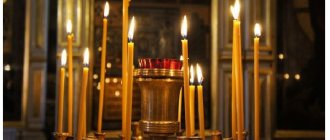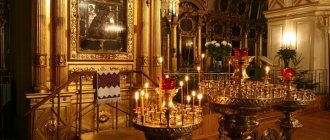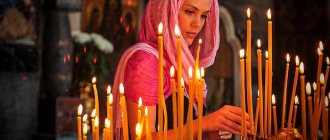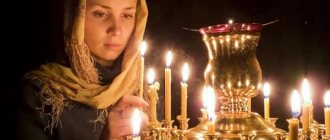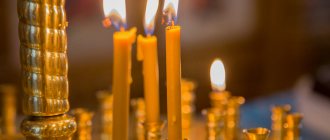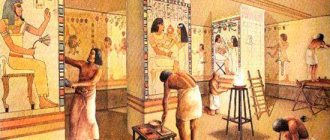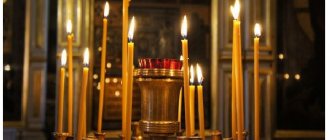There is an opinion that a church candle symbolizes a sacrifice given of one’s own free will to the Lord and his House, a testimony of one’s faith and sincere love for him. In the fifteenth century, one of the liturgists testified that a lit candle in a holy place is nothing more than a confirmation of the purity of the person who lit it.
About the author About the book
The wax that flows down the candle seems to indicate that the person agrees to follow the commandments of God, fulfilling them unquestioningly. This symbolizes that a person repents to the world for his actions. A candle is a guide towards God’s consciousness.
Before lighting candles for the repose, you should figure out how to do it correctly. It is important to understand the sequence of actions and who is allowed to address them.
Why do they light candles for the repose?
Light a candle online on the Svyattsy (Candle for the Repose) website.
Offering sacrifice to the Lord is a long-standing custom. It arose as a result of people’s fear of angering higher powers - they decided to appease them by sharing their spoils. However, the question arose - “how to transfer gifts to forces that do not have physical embodiment?” After much thought, a method was found - turning the prey into smoke. Vegetable and fruit crops, animals and even people were presented as treats.
Work as a courier at Yandex.Eda (up to 3,400 rubles per shift) leave a request →
But when the New Testament appeared, there was a transformation in the concept of sacrifice. People who believe in God have acquired new values and guidelines. The presentation to the Higher Powers became symbolic - it was a wax candle, which has retained this role in the present time. At the same time, the purpose of the offering was transformed - now, when purchasing a candle in a sacred place, these funds were spent on improving the house of the Lord. In this case, it does not matter at all what the price of candles is and how many there will be. Lighting a candle in front of the images is a symbol that a person is ready to become part of the holy place and prayers . To reinforce the request for the repose of the soul of the deceased, prayer words must be read.
A candle for the repose is a ritual that helps convey a piece of love and good thoughts to a deceased person. His soul will understand that he is remembered and remembered with warmth.
Holding a wake
Funeral services are scheduled for 3, 9, 40 days. It is best to do them in the house where the deceased lived, inviting only the closest people.
Funerals are carried out following certain rules:
- it is necessary to exclude the presence of so-called “violent products” on the table (these primarily include meat and fish);
- you should stop drinking alcohol, as this lowers the vibrations of both the living and the deceased;
- Sobbing and other strong manifestations of grief should be avoided (it should be remembered that the soul of the deceased is nearby and is aware of everything, and the suffering of loved ones causes it great discomfort).
At a wake there must be kutia and pancakes. According to tradition, the first pancake is broken by hand and left on the windowsill for the deceased. It is impossible to cut food for the deceased, since he will not be able to taste the energy of such products. A glass of drink and a photograph of the deceased person are also placed on the windowsill.
In addition to kutya and pancakes, porridge with butter and other lean dishes may be present on the table. Drinks include jelly and uzvar.
After the funeral, the photograph of the deceased is removed. It will be possible to hang it on the wall or put it on a shelf only after a year.
How to properly light a candle for repose after death
Before you light a candle, consider how deeply you believe in its power. Sincere faith is one of the main rules for the effectiveness of this action . The very purchase of candles in the temple already indicates your pure thoughts and real awareness of the result.
Before going to church, it is necessary to prepare for Confession and Communion - these are the rituals that are necessarily present in the divine service.
It is worth considering that it does not matter at all how many candles you put - it will not speed up the fulfillment of your desire. It should be understood that by installing a candle, you are not performing any magical ritual; this is a voluntary action. Neither the price of candles nor their number will help fulfill your hopes and desires faster. It is recommended to buy candles in the church - this way the money will go to benefit the sacred place.
A divine service is not complete without a candle. When setting it on fire, you need to read the prayer words. You can make an appeal to God in your own words, the main condition is sincerity.
The symbolic meaning of a funeral candle
A memorial candle is a symbol, a reminder to the Lord of a deceased person. People buy candles for funeral rites not only because of the death of a loved one, but as a sign that the person lived in this world. The light of a funeral candle is the best proof of this. It is known that the fire from a candle always points upward. Even a tilted candle reaches upward with its light. This is how a pious person should reach out to God in all his thoughts and aspirations.
During the burial ceremony, 4 candles on the sides of the coffin symbolize the cross, and a memorial candle in the hands of relatives and friends during the funeral service means the Divine light that every person receives during baptism.
Where to place a candle for repose
Become a courier of the Yandex.Food service right now (up to 3,400 rubles per shift) leave a request →
The question often arises: “Where are candles placed for the repose?” - a special place in the temple is intended for this ritual. In most cases, it is located at the entrance to the hall, on the left side of the door. Often this is a marble or metal table with cells, which is called a kanun. If there is no special table for this ritual, then it is permissible to place a burning candle on any candlestick. The offering that you brought with you must be placed in the baskets that are located near the eve.
Next, we will look at the procedure for how to properly light a candle for the repose.
The first thing you need to do is buy a candle in a shop, which is often located at the entrance to the church - by doing this you will do a good deed for the prosperity and existence of the holy place. Next, you need to find an icon that depicts the Crucifixion of the Lord and cross ourselves twice, standing opposite it. Often, next to this image there is a marble or metal table with cells (kanun).
Next, you need to light a candle from a lamp or from already lit candles . At the same time, pay attention that the wax does not drip onto the table or cells. Next, we fix the candle on an empty candlestick in a vertical position so that it does not touch other items. Check how stable it is. If there are no empty cells, then place an unlit candle side by side on the table (later it will be lit by church servants).
Then you need to read the prayer words (out loud or silently) - you can also read the text of the prayer, which is placed in front of the table with cells. Pronounce the words with deep faith in them and realize, feel with all your soul what you are saying. Cross yourself, bow. Complete the ritual by stepping aside.
About the author About the book
The need to pray for departed loved ones
After death, a person’s soul awaits aerial ordeals and the judgment of Christ. During the air ordeals, demons will attack the soul: they will remind the person of his past sins and will try to take him with them to hell. The fervent prayer of loved ones immediately after his death can help a person during these terrible trials.
The judgment of Christ, which awaits the soul after death, is the so-called private judgment. And all people also face a common one - the so-called Last Judgment, which will take place after the second coming of Christ. Anyone who is justified and taken into heaven by Christ after a private trial is no longer subject to a general trial. However, the fate of someone who was condemned by a private court can change before the Last Judgment through the prayers of his relatives and the entire Church.
Therefore, the departed need our prayers, and remembering them in the very first days is the most important duty of a Christian.
On what day are candles lit for repose after death?
Lighting a candle for the repose of the deceased is allowed on any day of the year. At the same time, the calendar highlights days of remembrance of the dead, when special services are held in sacred places. As a rule, parishioners order a memorial service; you can also simply light a candle for all the deceased of the family. Among these days are:
- Meat Saturday - occurs 2 days before Maslenitsa;
- Trinity Saturday - occurs on the eve of Trinity;
- Second, third and fourth Saturdays of Great Lent.
- Radonitsa - occurs on the second Tuesday after Easter.
The instructions of the church state that a lighted candle can be placed on the day when a person passed into the other world. The burning candle must remain for at least forty days - this will illuminate the path for the soul of the deceased. In accordance with Christian customs, a candle must be lit in the room in which the coffin is placed. It must be extinguished after the deceased is removed from this room. The funeral candle is then lit at the funeral meal. You should definitely read the prayer words for the soul of the deceased.
The question arises: “How many candles need to be lit?” To illuminate the path of one soul, you can put one or more candles. The same is possible if you are seeing off several deceased people.
If you did not make it to the service, perform a funeral ritual after the end of the service.
How often candles are placed is determined by your own preferences and wishes, the main thing is to do everything correctly and place the candle in the place that was designated for this.
Tales ancient and new
The High Priest's Eternal Torment
Once the great ascetic St. Macarius of Egypt, walking in the desert, saw a human skull on the road. “When I,” he says, “touched the skull with a palm stick, he said something to me. I asked him:
- Who are you?
The skull responded:
“I was the chief of the pagan priests.
—What is it like for you pagans in the next world? - asked St. Macarius.
“We are on fire,” answered the skull, “the flames cover us from head to toe, and we do not see each other; but when you pray for us, then we begin to see several of each other, and this gives us joy” (Chronicles Reading, part 2, 1821).
About a monk who escaped posthumous punishment
St. Gregory Dvoeslov tells such a case. One brother, who was in his monastery, for violating the vow of non-covetousness, to the fear of others, was deprived of church burial and prayer for 30 days upon death, and then, out of compassion for his soul, a bloodless sacrifice was made for him with prayer for 30 days. On the last of these days, the deceased appeared in a vision to his surviving brother and said: “Until now I suffered severely, but now I feel good, and I am in the light, for today I entered into fellowship.” Thus, through a saving bloodless sacrifice, the deceased brother escaped punishment (“Conversations of Gregory Dvoeslov”, book IV, chapter 55).
About a novice who lived in carelessness
One of the God-bearing fathers, says St. John of Damascus had a disciple who lived in carelessness. When this disciple was overtaken by death in such a moral state, the humane Lord, after prayers offered by the elder with tears, showed him his disciple, engulfed in flames up to the neck. When his elder labored a lot and prayed for the forgiveness of the sins of the deceased, God showed him a young man standing waist-deep in fire. Then, when the good man added new labors to his labors, God in a vision showed the disciple to the elder completely freed from torment (“The Word about those who have fallen asleep in the faith” - Chronicle reading, 1827, part 26).
The story of two chatty fast women
During the life of Venerable Benedict, says St. Gregory Dvoeslov, there were two fasting women who, famous for the holiness of their lives, had an unfortunate passion for saying a lot, and a lot of false and harmful things. The holy elder begged them to hold their tongues and even threatened them with excommunication for disobedience. But the passion for lies was so ingrained that even the threat did not stop them. After some time, they died. These fasting women were buried in the church. When the deacon during the liturgy exclaimed: come forth from the catechumen
, they, as if excommunicated, left the church, which some pious Christians saw. When the Monk Benedict was informed about this, this holy man sent a prosphora to the church where they were buried, ordering that a portion be taken out of it for the repose of their souls and to remember them. After this, no one saw them leave the church, and the faithful realized that the prayers for them had propitiated God, and they received forgiveness from Him (“Conversations of Gregory the Dvoeslov”, book II, chapter 23).
About a young monk who secretly visited his parents
In the life of Rev. Venedikt, another case is given that demonstrates how much commemoration means to the dead. So, in the monastery where the Rev. lived. Benedict, there was one rather young monk who, out of excessive love for his parents, secretly left the monastery almost every day, leaving without the blessing of his superior. And finally, God’s punishment befell him. Arriving, as usual, at his parents’ house, he died suddenly. They let the monastery know about this, and the brethren buried the deceased. But what? The next day in the morning they saw the body of the deceased thrown out of the coffin. They buried him again, and again the next day the body was outside the coffin. Then they said to St. Benedict, and he ordered a bloodless sacrifice to be made for him and, putting part of the St. Gifts on the face of the deceased, interred. Indeed, after this, the body of the deceased no longer erupted from the coffin, which clearly testified to the granting of God’s mercy to him through the prayers of the monastery brethren (Life of St. Venerable Benedict, March 14).
***
If the prayerful remembrance of the departed brings joy and salvation to the departed souls, then the prayer that is accompanied by deeds of mercy, such as alms, offerings to St. temple of candles, oil, incense, etc.
Here are a few examples demonstrating the beneficial nature of almsgiving in memory of the dead.
About a monk who broke his vow of non-covetousness
The prologue tells that the blessed Cyrus Luke had a brother, who, even after entering the monastic rank, cared little about his soul. In a state of such carelessness, his death befell him. Blessed Luke, grieving that his brother did not prepare as he should for death, prayed to God to reveal his fate. One day the elder saw his brother’s soul in the power of evil spirits, and immediately after this vision he sent to inspect his cell. Those sent found money and things there, from which the elder concluded that his brother’s soul was suffering, among other things, for violating the vow of non-covetousness. The elder gave everything he found to the poor for the repose of his soul. After this, during prayer, the elder saw in a vision a judgment seat, at which the Angels of light were arguing with the spirits of evil about the soul of a deceased brother. The elder hears the cry of evil spirits: “Our soul, it did our deeds!” But the Angels tell them that she has been delivered from their power by the alms given for her. To this the spirits of evil objected: “Did the deceased give alms? Isn’t this the old man?” pointing to blessed Luke. The ascetic answered: “Yes, I did alms, but not for myself, but for this soul.” The desecrated spirits, having heard the elder’s answer, went bankrupt, and the elder, calmed by the vision, stopped grieving over the fate of his brother (Prologue, August 12).
About negligent sisters
In the life of the Venerable Abbess Athanasia we find the following narrative. Before her death, Abbess Afanasia bequeathed to the sisters of her monastery to feed the poor in her memory for up to 40 days. Meanwhile, the sisters invited beggars only for 10 days, and then, due to negligence, did not fulfill the will of their former boss. And what? Abbess Athanasia appeared from the afterlife and reproached that the sisters had violated her request, saying: “Let it be known to everyone that alms and food for the hungry, done up to forty days for the soul of the deceased, appease God. If the souls of the departed are sinful, then through this they receive remission of sins from the Lord; and if they are righteous, then charity for them serves to save the benefactors” (Ch. Menaion, April 12).
***
There are many examples from which it is clear that the deceased themselves expect living prayers for themselves, appear to them in a dream or in a waking state, assuring them that they need prayerful remembrance of them, asking for it, showing this in various signs or images.
Mysterious bathhouse attendant
St. Gregory the Dvoeslov says that a certain presbyter used to wash in greenhouses. One day, having come to the bathhouse, he found some husband unknown to him there, who began to help him undress. The stranger took off the presbyter's boots and took his clothes for safekeeping. When the presbyter left the bathhouse, he gave him a linen to wipe off the sweat, helped him get dressed, and did all this with great respect.
This was repeated several times, that is, this presbyter, coming to the bathhouse, met a stranger who silently did him a favor. Wanting to express his gratitude to him for his diligence, the presbyter one day, going to the bathhouse, took two prosphoras with him to give them to a stranger; and so, as usual, he met him here. Then, when he left the bathhouse, he asked to accept the prosphora as a sign of love for him. The stranger said to him weeping:
- Father! Why are you giving this to me? I can't eat. I was once the owner of this place, but I am condemned here for my sins. If you want to do something for me, then bring this bread to Almighty God for me, and pray for my sins, and know that when you come here to wash and don’t find me here anymore, this will mean that your prayer has been heard by God.
Having said this, the stranger instantly became invisible. Then the presbyter realized that the stranger, who had hitherto appeared in the bathhouse to serve him, was a spirit. The presbyter spent a whole week for him in tears and prayer for the forgiveness of his sins, making a bloodless sacrifice every day. A week later he came back to the bathhouse and no longer found the stranger here and after that he never met him (“Conversations of Gregory the Dvoeslov”, book IV , chapter 55).
The story of Deacon Paskhazia
There was in the Roman Church, says Gregory Dvoeslov, a deacon named Paschasius, a man of exemplary life, merciful to the poor and strict with himself. When in his time, in place of the deceased Pope of Rome, two persons were presented to the electoral council - Lawrence and Symmachus, and when the latter was unanimously elected and elevated to the episcopal throne, then Paschasius, committed to Lawrence, was indignant at the election of the council, considering it incorrect, and in this Due to the sin of indignation at the shepherds who dedicated Symmachus, he died.
Some time after his death, Paschasius appears to Bishop Germanus and tells him: “I am at the place of punishment for the fact that, holding on to Lawrence, I thought against Symmachus; but you pray to the Lord, and if in a few days I do not appear to you again, then know that your prayer has been heard.”
The pious bishop fulfilled the request; and since no new appearance followed, he was convinced that his humble prayer had won eternal peace for the soul of Paschasius (“The Word about those who have fallen asleep in faith” - Chronical reading, 1827, part 26).
***
A few more examples from a very close time to us.
Vision of eternal torment
One of the Athonite ascetics revealed the following to the holy mountain dweller, the famous Father Seraphim: “The reason for my entry into monasticism was a vision in a dream of the afterlife fate of sinners. After a two-month illness, I became very exhausted. In this state, I saw two young men come in to me. They took my hands and said:
- Follow us!
I, not feeling sick, got up, looked back at my bed and saw that my body was lying calmly on the bed. Then I realized that I had left earthly life and must appear in the afterlife. In the faces of the young men I recognized the Angels with whom I went. I was shown fiery places of torment; I heard the cries of the sufferers there. The angels, showing me for which sin which place of fire was assigned, added:
“If you don’t give up your habits of sinful life, then this is your place of punishment!”
Following this, one of the Angels snatched one man from the flame, who was black as coal, completely burned and shackled from head to toe. Then both Angels approached the sufferer, removed his shackles - and with them all his blackness disappeared: he became pure and bright, like an Angel. Then the Angels clothed him in a shining robe like light.
“What does this change in this man mean?” I decided to ask the Angels.
“This is a sinful soul,” answered the Angels, “having been excommunicated from God for its sins, it should burn forever in this flame; Meanwhile, the parents of this soul gave a lot of alms, made frequent commemorations at liturgies, held funeral services, and for the sake of the parental prayers and the prayers of St. Church, God was appeased, and perfect forgiveness was granted to the sinful soul. She is delivered from eternal torment and will now appear before the face of her Lord and will rejoice with all His saints.
When the vision ended, I came to my senses and what did I see? They stood around me and cried, preparing my body for burial” (“The Wanderer,” 1862, May).
About the bishop's choirboy
In 1871, a singer in my choir died of epidemic cholera, no more than 24 years old, as Archbishop Neil reported. Nine days after his death, precisely on the morning of July 16, he appeared to me in a dream. After some questions were made by the saint who had appeared, the archbishop was asked:
- How do you feel?
“I’m sad,” answered the singer.
- How can we help this? - asked the bishop.
- Pray for me: to this day, funeral liturgies for me have not been performed.
At these words, my soul was indignant, says His Eminence, and I began to apologize to the deceased for not ordering the magpie, but that I would certainly do so. The last words apparently calmed the interlocutor who had appeared from another world” (“Soulful Reflections” (1878–1879), pp. 131 and 132).
***
Receiving joy and relief from the prayers of the living, the dead sometimes appear and thank their prayer books or try to do something in turn to help them.
Father's gratitude
In one village, an old sexton died suddenly. He had a son - an official. The unexpected death of his father struck his son. The afterlife fate of the deceased haunted the good son for almost a whole year. Knowing that in the liturgy the most important time for commemorating the dead is the time of singing: “We sing to You, we bless You...”, the sad son, being in the church at that very time (it was on Spiritual Day), with special zeal began to pray to God for repose my father. And what? On Tuesday night, he sees in a dream his father, who bowed to the ground three times and, with the last bow, said: “I thank you, my son” (“The Wanderer,” 1864, December).
Request from a deceased relative
Returning from Matins on the first day of Easter, I, reports A.E.B., went to bed, and had barely forgotten myself when I heard at my very bedside that someone was crying bitterly. My heart sank with pity: afraid to open my eyes, I timidly asked: “Nadya, is that you, my dear?” - and I was afraid to hear the answer, because it occurred to me that perhaps my sister Nadya, who had died long ago, having not received bliss in eternal life, appeared to me to ask for prayer, but she answered my question in a gentle, sad girlish voice, trembling with sobs , came the answer: “No, I’m not Nadya.”
-Who are you? - I asked. - Tell me, what do you need? I'll do everything.
Then the sobs intensified and the crying woman answered:
- I am Varvara P., for God’s sake, pray for me, remember me during the liturgy.
I promised, and the sobs subsided. I opened my eyes, the room was already light and there was no one.
When P.’s relatives came to us, I asked my husband’s brother-in-law what the name of his sister was, who died recently in Moscow. He answered: “Varvara Nikolaevna.” Then I conveyed my vision. He was amazed by the story and immediately became concerned about commemorating his sister (“Soulful Reflections” 1882, issue 5).
The story of the drowned dragoman
In November 1851, our singers left us for Jerusalem, says Holy Mountain priest Fr. Seraphim. Monk N., who a little earlier wanted to leave the monastery, was given to them as a dragoman (translator from Eastern languages). God knows what his life was like, especially in Jerusalem; Only later was his abuse of the name of the monastery discovered: he made a false signature of the abbot on a sheet with the official monastery seal and made collections in Palestine with this sheet. The period of their wanderings has happily ended; Easter has passed; our singers left Jaffa for Sinai, and N., among the Russian fans, boarded a ship departing from Jaffa to us on Athos.
On the first night, when everyone had settled down in their places on the ship, in the darkness of the night, during the rocking, N., dressed in a Russian fur coat, for some reason made his way to the front of the ship and, God knows how, he broke off and flew into the sea... It was heard three times to the ship a voice begging him: “Save! Save!”, but after a few minutes these words died away in the distance, and the very sound of the voice merged with the howl of the wind and storm. N. drowned.
A week after this misfortune, precisely at the end of November, one of the monastic brethren S. was suddenly struck by a vision. The drowned man N. enters his cell and, having just crossed the threshold, said:
- Don’t be scared of me, I’m not a ghost, but really N.
Brother S. peered into the face of the deceased and asked with incredulity:
- Aren't you a devil?
“No,” answered the one who appeared, “I am truly N.”
- And read: “ May God rise again”
, - S. told him, - and cross yourself, then I will believe that you are not a demon.
“You cross me,” the person who appeared remarked, “and read May God rise again, then you will be convinced that I am definitely N.”
S. crossed himself and began to read a prayer. When it came to the words: So let the devil perish on behalf of those who love God
, N. interrupted him and read: “
So let sinners perish from the face of God, and let righteous women rejoice,” and
taking a deep breath, thought. Then he humbly began to ask that they pray for him.
- Do you need our prayers? - asked S.
- Oh, and how I still need it! - he answered with a sigh and, taking S.’s hand and squeezing it tightly, he continued:
- Please pray for me.
“Yes, I don’t know how to pray for myself either,” objected S., “you have to ask your confessor about this.”
“And ask,” said the one who appeared, “ask all the brethren to pray for me.”
“Sit down,” S. told him.
- Oh no, I was given a little time, and I flew here from afar and was in a hurry...
Then it suddenly occurred to S. to ask N. to make peace with the brethren.
N. thought for a moment, then sighed and said sadly:
- It’s not the time now.
Meanwhile, S. noticed that the deceased’s skull was broken.
- What do you have? from what? - he asked the one who appeared, pointing to the broken place.
“And when the waves brought me to the shore, my head smashed on a stone.”
Then, again asking that they pray for him, N. hastily said that it was time for him to return, and disappeared (Works of Svyatogorets. - Letter to Friends, Vol. III).
A wonderful icon of a fallen officer
On July 2, 1893, the rector of the Peter and Paul Church, Father Dimitry Koiko, and one of the members of the local intelligentsia, a man with a higher education, appeared to His Grace Martinian, Bishop of Tauride and Simferopol, and reported to the Bishop about the following.
On the night of June 30th, the said person had a dream that some officer with a bloody bandage on his head approached him and asked him to convey the question to the priest of the Peter and Paul Church: “Why doesn’t he pray for him, and also doesn’t pray to those saints of God, whose relics are in the icon he donated, and he added that on Elijah this image will be 200 years old.”
The one who saw this dream immediately in the morning went to the rector of the Peter and Paul Church and told him his dream. To this o. Dimitri noticed that there is no 200-year-old icon in the church, since the church itself has existed only since 1805, and there are also no icons with particles of relics, but that he is surprised by the appearance of the officer in a dream, since there is an icon in the church, which, as he said His predecessor, Archpriest Rudnev, now deceased, was brought to him by some officer during the Crimean campaign and left in the church under the condition that if he returned from Sevastopol, he would take the icon back, but if he did not return, he would donate it to the temple. The unknown officer did not return, and the icon remained in the church.
This coincidence of the dream about the officer with the above-mentioned icon prompted Fr. Dimitri Koiko to inspect this shrine, and Fr. Demetrius testified both to the person who conveyed the dream and subsequently to the bishop that, being a member of the church for 14 years, he never once opened that image. The deacon was immediately sent for, and all three persons went to the church to examine the icon. The icon represented a cypress board on which the Holy Trinity was depicted in ancient painting, as well as the faces of several saints. A silver cross was placed in a special recess. When they took it out with great difficulty, it turned out that it moved apart, and in the middle of it they found the relics of St. Lazarus, St. great martyr Theodore Stratelates, St. ap. and ev. Luke and St. firstmuch. and archid. Stefan. The inscriptions indicated that there were also other particles, including the first particle. Thekla. But those viewing it were in for an even greater surprise: at the bottom of the cross, in barely noticeable Slavic script, there was a carved inscription reading 7201 from the creation of the world, and therefore, that year the icon turned 200 years old.
When this was reported to His Eminence Martinian, the Bishop ordered that funeral litanies for the soldiers who died on the battlefield for the Faith, the Tsar and the Fatherland be performed daily in this church (“Light”, 1893, No. 189).
Chained Priest
In one parish, on the occasion of the death of a priest, his place was taken by another. But, to the regret of the parishioners, the newly appointed priest, a few days after the first service he performed in the church, passed away into eternity. A new priest was appointed. Upon arrival at the parish, he took office and on the first Sunday went to church for worship. Entering the altar, the priest involuntarily fixed his gaze on one object that terribly struck him: near the throne stood an unfamiliar priest in full vestments, bound hand and foot with iron chains. Not understanding what this meant, the new clergyman, however, did not lose his spirit and began to celebrate the Divine Liturgy.
As soon as the service was over, when the new mass was being celebrated in surprise, the ghost suddenly disappeared. The officiating priest realized that the priest he saw was an inhabitant of the afterlife; but I couldn’t figure out what his extraordinary appearance in such a terrifying form meant. He only noticed that the prisoner and brother, unknown to him, did not utter a word during the entire Service and only from time to time, raising his shackled hands, pointed to one place on the platform in the altar, on which, apparently, there was nothing special. The same thing was repeated in the next service, with the only difference being that the new priest, upon entering the altar, first of all paid attention to the place to which the ghost was pointing. In the corner on the floor, near the altar, he noticed an old small bag. When he untied it, he found in it a considerable number of notes with the names of dead and living persons, which are usually given for commemoration at the proskomedia.
As if by inspiration from above, the priest realized that these notes, during the life of his shackled brother standing here, who was the rector of the same church, probably remained unread by him at one time. Therefore, having begun the service, he first of all remembered at the proskomedia the names of the living and the dead, how many there were in the notes, and immediately saw what an important service he had rendered to the afterlife inhabitant by fulfilling what the latter had to do during his earthly life, for he barely As soon as he finished reading the aforementioned notes, the iron shackles fell off the prisoner’s hands and feet in an instant, and he himself approached the serving priest and, without saying a word, bowed at his feet to the face of the earth. Then suddenly neither he nor the iron shackles were visible. After this, the creature from beyond the grave no longer appeared during the divine service (“The Wanderer,” 1867, vol. I).
The afterlife messenger
In 1831, on February 28, Infantry General Stepan Stepanovich Apraksin died in Moscow. In his young years, he briefly met Prince Vasily Vladimirovich Dolgorukov. Both of them served in the same regiment: the first with the rank of colonel, the second - major. Dolgorukov died in 1789 in complete poverty, so there was no means to bury him. His friend Stepan Stepanovich Apraksin arranged the burial and commemoration of the prince at his own expense; it seemed as if he had paid his last debt to his own brother.
On the third day after the funeral, the deceased Dolgorukov appeared to his benefactor in order to bring him his gratitude. The mysterious guest predicted a long and prosperous life on earth for his constant and compassionate friend and promised to appear shortly before his death.
After that, the good Apraksin was especially attentive to the needs of the poor and rejoiced whenever an opportunity for charity presented itself to him.
42 years passed, and, true to his promise, Prince Dolgorukov visited the elder general a second time at ten o’clock in the evening. First of all, the prince considered it necessary to remind him of himself and the benefit that had been shown to him many years ago, then he exhorted his friend to prepare for death, which would follow in 20 days, promised to visit him again three days before his death, and suddenly left from the room.
Apraksin believed the words of the afterlife messenger: he confessed, took communion and was blessed with oil. Three days before his death, he invited one of his friends to stay with him for the night. At 11 o'clock at night Dolgorukov appeared and entered into a conversation with Elder Apraksin. His friend who was present later told many that during Apraksin’s conversation with Dolgorukov, he felt involuntary fear, although he did not see the prince who appeared, but he heard his voice.
Three days later Apraksin died. After his death, rumors circulated in Moscow for a long time about his meetings with the late Dolgorukov (“Soulful reading”, 1867, part I).
Dream of Saint Philaret of Moscow
One priest with particular zeal commemorated the dead during the liturgy, so that if someone once gave him a note of commemoration, he wrote down the names of the deceased in his synodik and, without telling the person who submitted it, he commemorated them all his life. Following this rule, he compiled a synodik with such a multi-thousand-strong list of names that he had to divide it into sections and commemorate them in turn.
It happened that he fell into some kind of error, so that he was threatened with removal from the parish. The case was transferred to Moscow Metropolitan Philaret, and when the Right Reverend was about to put down a resolution to eliminate him, he suddenly felt some kind of heaviness in his hand. The Metropolitan postponed signing the journal until the next day. At night he sees a dream: a crowd of people of different ranks and ages has gathered in front of the windows. The crowd is loudly talking about something and making some kind of request to the Metropolitan.
“What do you need from me,” asks the archpastor, “and what kind of petitioners are you?”
“We are departed souls and came to you with a request: leave us a priest and do not remove him from the parish.”
The impression of this dream was so great that Filaret could not get rid of it upon awakening and ordered the condemned priest to be called to him. When he appeared, the Metropolitan asked him:
- What good deeds do you have behind you? open it for me.
“No, Vladyka,” answered the priest, “I am worthy of punishment.”
- Do you remember the dead? - the Metropolitan asked him.
“Well, Vladyka, I have a rule: whoever submits a note, I always take out pieces about them at the proskomedia, so the parishioners grumble that my proskomedia is longer than the liturgy, but I really can’t do otherwise.”
The Eminence limited himself to transferring the priest to another parish, explaining to him who was the intercessor for him (“The Wanderer,” 1862, May).
***
“But who can count,” exclaims St. John of Damascus - all the evidence found in the lives of holy men, in the descriptions of martyrdoms and in divine revelations, clearly showing that after death, prayers performed for them and alms given for them bring the greatest benefit to the deceased" ("The Word of Those Who Reposed in Faith" - Chr. reading, 1827, part 26.).
Is it possible for pregnant women to light candles for the repose?
In ancient times, going to a sacred place was prohibited for a pregnant woman. In current realities, this problem has begun to be looked at from a different angle. They began to think that the child that is under a woman’s heart is the fruit of the love of two people and the Lord.
Despite the fact that pregnant women are allowed to visit the holy place and light candles, there are still restrictions for them: they are not allowed to visit the temple for forty days after a miscarriage or after childbirth - until the bleeding completely stops.
- How to order a magpie for the repose correctly;
- Prayer for the unbaptized dead;
- What to do on the 9th day after death.
Why are funeral prayers necessary?
None of the people knows when the hour of death will strike. It may happen suddenly or after a long illness, but that day will come. It is important to be prepared for this, because it is inevitable for everyone without exception.
People do not think about their sins and actions throughout their lives. Time is wasted on stupid things, entertainment and satisfying worldly needs, on useful things, taking care of family well-being, raising children. How many nerves and worries are wasted, but you should take care of your soul. But not everyone confesses during their lifetime, so a prayer for the repose of the soul of the deceased after 40 days, and immediately after death, a “prayer for the departure of the soul,” will help relatives. It also helps when a person is in agony and the soul cannot leave the body.
The soul wanders for 40 days. After the funeral service and burial:
- the first three days the soul is next to the mortal body and sees all its loved ones and relatives, can visit its favorite places;
- then the Lord calls her to himself and gives her the opportunity to observe for six days how they live in paradise;
- on the ninth day, the Lord decides where to send the soul; if a person sinned, did not repent, did not confess, then he sends the soul to hell, where it sees the suffering of sinners; at this time, all sins are listed by demons, they can drag them to hell, but relatives can pray and ask the Lord to alleviate suffering;
- On the fortieth day, the Lord makes a choice where to send the soul to hell or heaven.
Therefore, it is so important to read prayers and order a service for the repose of the soul for the deceased. On the fortieth day the soul stops hovering. On this day, one must ask the Lord to take the soul of the deceased and give peace to the one praying.
If a person has committed suicide, then prayers will not help. There are certain texts, psalms, akathists that read about calming the soul. At the service, notes about such dead people are not given; you can pray for them at home. Suicide is considered a sin, so the names of the deceased cannot be remembered at services.
It is difficult for the soul to calm down if the deceased has committed a terrible sin and has not repented. In this case, in addition to prayers, it is necessary to distribute his things to those in need and fulfill the will of the deceased. This will help you get through suffering and ordeal.
Also read: Prayer for drunkenness to the Mother of God “Inexhaustible Chalice”
If a person was an alcoholic, drug addict or crazy during his lifetime and there are doubts about his suicide, in this case it is necessary to talk with a sacred minister. Perhaps the deceased was in a state of insanity at the time of death and was not aware of his actions. Some sacred ministers allow the names of these people to be mentioned in services, but funeral services for suicides and unbaptized people are prohibited.
Is it possible to light candles for the repose of an unbaptized person?
The question often arises: “Who can I light a candle for the repose of? Is it possible for unbaptized souls? The answer to this question depends on who you want to ask God for - for a bewitched person or an adult.
There are cases when a baby dies after childbirth. Naturally, in such a short time his parents could not baptize him. In this case, the mother should turn to Saint Huar - it is believed that he can put in a word for the deceased before the Lord.
However, praying for adults who have not been baptized is not allowed in a holy place. It is believed that this person does not exist for the Lord and all prayers for him will be in vain. His name cannot be mentioned during the liturgy or indicated in notes to prayers. But it is permissible to light a candle for him. Praying for such a deceased person is allowed at home.
Mistakes loved ones make at funerals
Many people do not know how to behave during funeral ceremonies, before and after them. There are funeral rules to avoid mistakes at funerals. It is advisable to know about them so as not to bring new misfortune and troubles upon yourself and your loved ones.
- Do not put various things “as a keepsake” in the coffin, for example, photographs, your personal belongings, children’s toys, and so on. This promises the appearance of the next dead person. The same applies to the things in which the deceased is dressed - you cannot give the clothes of another person, so as not to make him sick.
- Many people make the mistake of putting fresh flowers in the coffin. To do this, you need to use only artificial bouquets or dried plants.
- Under no circumstances speak about the deceased in negative terms, and, moreover, do not scold or insult him, no matter what he did to you during his lifetime. As they say: “either good or nothing”
- There is no need to hug relatives at a funeral if they have not seen each other for a long time - this conveys illness and a dead spirit.
- It is a serious mistake to arrange quarrels and any conflict situations in the cemetery. It is especially serious if you are cursed at a funeral. This promises quick death. To somehow protect yourself, you need to read special prayers.
- Few people know the following prohibition and therefore make a mistake. Thus, it is not recommended to visit the graves of other relatives or friends after the funeral. This cannot be done, because you must devote this day exclusively to the deceased.
Mon, 19 Jul 2022 11:01:52 +0300
Kalinina Natalya
